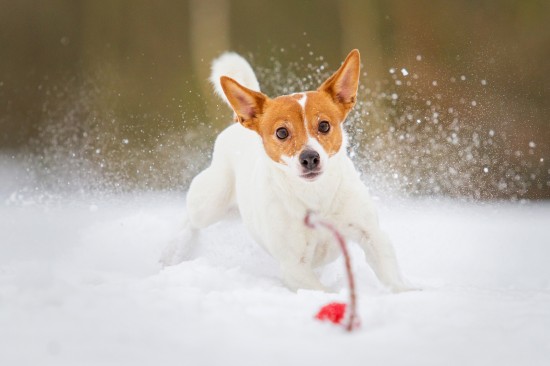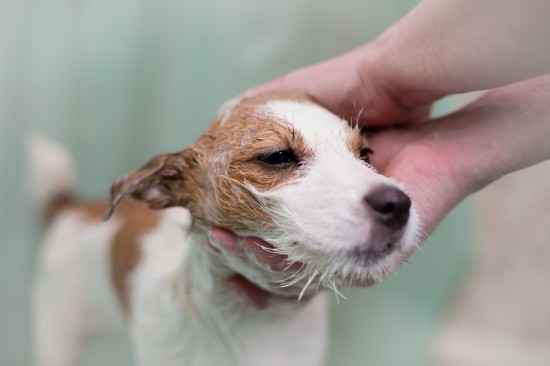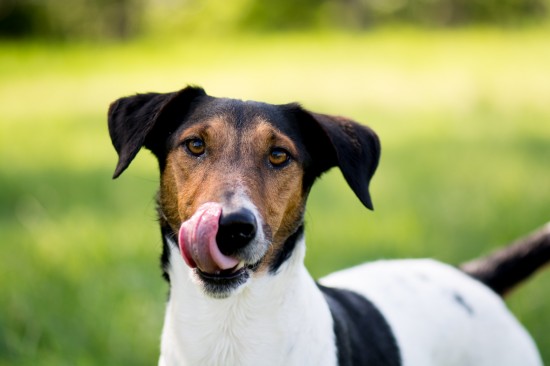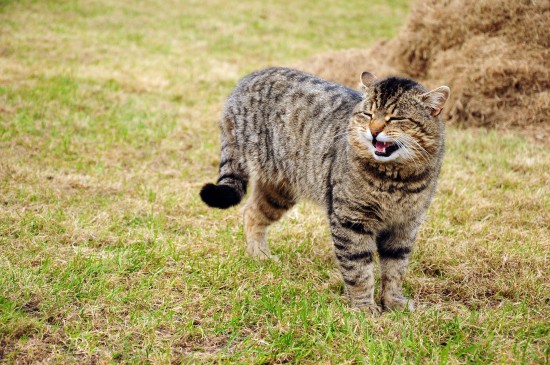Description: The Bullmastiff dog breed is not cumbersome, but it is still a very powerful and large dog. This dog has a large Broad head, with a broad muzzle that is the usual dark colour. It has large nostrils, and is wide nosed. The skin is loose around the face, adding character that looks soulful but alert. This breed has an undershot bite. They have medium sized eyes that are hazel in colour. Their ears are set high and wide apart in a V Shape that hang downwards. This adds an overall square shape to the dogs face. The dog's height is 25 to 27 inches with the bitches measuring 24 to 26 inches. Their weight is between 95 to 130 pounds, depending on sex. Their tail is set high, is broad at the root and can be either straight or curved, reaching down to the hocks. This breed has a short, but straight back, showing the powerful build of their body. They have a dense, short and slightly rough coat. Colours are red, fawn and brindle this breed often comes with black markings on their head. This dog lives for about 10 years.
History: As the name suggests, the bullmastiff was created by crossing 40% Bulldogs with 60%. Mastiffs'. This was done in England and records go back as far as 1795. Three generations of Bullmastiff's were required to be registered as a pure breed. This dog was used to track down and hold poachers for the local games keepers. Although this dog appeared fierce and threatening, they were trained not to bite the intruders, this kept out the poachers as the fear of this breed of dog grew. In its history, it has been used for hunting, guarding, helped the army and police in their work, and as a watchdog in many countries around the world. Today, this breed can be a reliable family companion.
Temperament: The Bullmastiff dog breed is devoted to his family, but it is still important to remember, its strong instinct as a guard dog, it is docile and friendly, but unafraid if aggravated. Although this dog is unlikely to bite an intruder. This dog's instincts are to catch, knocking down and hold him there. This breed craves human leadership, is even tempered, loyal and calm being even good with children. It is to be remembered this breed, as a particularly powerful and muscular dog needs a firm master, who is consistent with all the rules that are set for this breed. High levels of obedience training, is seen as a must for this breed. This dog needs to learn not to pull on the lead, and the master always goes first. Socialization is also important so that this dog, from a very young age is enabled to get along with other pets and other dogs. This dog is sensitive to your voice, and this needs to be assertive in style, but not harsh. This is not a dog for the meek owner as a dog can become wilful and possibly aggressive towards other dogs. You only need to be a good pack leader at all times.
Health issues: The Bullmastiff dog breed is prone to hip dysplasia, cancer, tumours, eyelid problems, PRA and boils on the lip and bloat which will need meals in small portions throughout the day.
Grooming: The Bullmastiff dog breed is easy to groom, due to short hair, brushing and combing is all that is required. This breed sheds little. Bath only when necessary. Care of the dogs paws is required due to the weight they carry.
Living conditions: The Bullmastiff dog breed will do fine in an apartment providing, they have been exercised, which covers both physically and mentally stimulation. A small garden will be fine for this breed.

 Recognising Hypothermia In Dogs
Recognising Hypot
Recognising Hypothermia In Dogs
Recognising Hypot
 Making A First Aid Kit For Your Dog
Making A First Ai
Making A First Aid Kit For Your Dog
Making A First Ai
 How To Cope With Dogs Suffering With Malassezia Dermatitis
How To Cope With
How To Cope With Dogs Suffering With Malassezia Dermatitis
How To Cope With
 Different Medication Options For Dogs That Suffer From Seizures
Different Medicat
Different Medication Options For Dogs That Suffer From Seizures
Different Medicat
 Caring For A Disabled Cat
Caring For A Disa
Caring For A Disabled Cat
Caring For A Disa